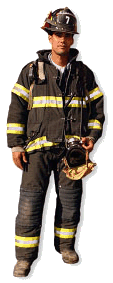 (September 2007) For thousands of office workers who fled the twin towers on 9/11, the most astonishing sight during the rush to descend was the wave of resolute firefighters making their own way upwards. Eleven firefighters from Rescue 1 went in. None returned. Seven from Engine 33 rushed in. Only the driver survived. “We found eight of them together in a stairway void,” said a rescue worker. “They were still holding their tools …” The number of casualties was astounding. Entire companies were lost.
(September 2007) For thousands of office workers who fled the twin towers on 9/11, the most astonishing sight during the rush to descend was the wave of resolute firefighters making their own way upwards. Eleven firefighters from Rescue 1 went in. None returned. Seven from Engine 33 rushed in. Only the driver survived. “We found eight of them together in a stairway void,” said a rescue worker. “They were still holding their tools …” The number of casualties was astounding. Entire companies were lost.
One of the cruelest facts of 9/11 was the inability to locate those brave souls who plunged into harm’s way, to warn them when to get out, and to locate those who were trapped when the towers collapsed. One reason was that they neither carried, nor wore, any sort of technology that could tell their command center where they were. As a result, it was a severe challenge to know where rescue personnel were once they were out of sight, enveloped in smoke or fire, and scattered across many floors.
This is all about to change.
It started when the Department of Homeland Security (DHS) Science and Technology Directorate (S&T) asked the boots-on-the-ground what they need. “One of the most important needs of the firefighters and other first responders turns out to be a technology that can accurately track and locate where their comrades are in three-dimensional space,” says Jalal Mapar, a program manager at the Directorate. “Now we’ve got a solution … the 3–D Locator.”
Mapar is developing an innovative 3-D Locator system with L-3 Communications Corporation—what he calls a “cocktail solution” that includes several components needed to track the first responder: an inertial measurement unit, altimeter, ultra-wideband radio, GPS, pedometer, magnetometer, barometric altimeter, Bluetooth, and wireless mesh network. Lightweight, and worn as a small daypack, the locator is achieving an accuracy of three meters.
“That’s good enough to identify even the floor the responder is on in disaster or emergency situations,” says Mapar.
The 3-D Locator uses an enhanced ad hoc network router, consisting of a processor for the entire system, an integrated radio, and an integrated 20-channel GPS receiver. “Ad hoc” technology assists by providing a private network to determine the location of a radio when GPS alone can’t do the job. It links individual GPS locators worn by first responders into a network that shares GPS satellite and other navigation information. If a firefighter’s locator is receiving only one satellite signal, it can share information from other locators receiving additional satellite signals, along with information about their relative location.
The current model is being prepared for testing in several large metropolitan areas around the country. Once fully developed, the 3-D Locators have potential use in thousands of applications for police, fire, and emergency medical personnel.
“It’s a game-changer that will save lives,” says Mapar.
To request more information about this story, please e-mail st.snapshots@hq.dhs.gov.
